While cleaning out my parents’ attic I found my old trains. Even after I had grown up and moved away, Mom and Dad still used them for years around their Christmas tree. Now, however, my trains have been boxed up and haven’t run for five years. I’d like to put them under my Christmas tree this year. How can I get them back to speed? – John Terra, Cherry Hill, N.J.
This is the time of year we get a lot of questions about putting together a Christmas tree layout. So here are some general suggestions, based upon your letter and many similar letters, to help you get your trains ready for the big day.
Keep things simple
A holiday layout is not the place to try out complicated track plans and control circuits. Design a layout the kids can handle by themselves. Most adults are occupied with many other things during the holiday season, so they’re happy to just sit back and watch trains run.
A basic oval, perhaps with one pair of switches to provide interest with an alternate route, is all that’s needed. If you want to run two trains, set up another oval inside the first.
Here are some track plan suggestions:
Integrate the scene
Tie the tree and the train layout together in some way. A winter scene works well, even in California. Accentuate the whimsical: cute buildings, oversized accessories, and blinking lights. Leave room for big presents under the tree. The train can be used to deliver the smaller ones.
You should also do something to set the layout apart from the rest of the room and protect the carpet. Little accidents happen – lubricating oil sometimes splatters, fake snow gets out of hand, artificial coal spills – and you’ll want something to contain or absorb these mishaps. If you’re doing a winter motif, a white bed sheet will work fine.
Prepare the track
If you’re using old Lionel or American Flyer track, examine each track section and make sure the rail fiber insulation (center rail on Lionel track) is still in place. If the track is warped or bent, straighten the rails by hand or with pliers. Badly damaged sections should be replaced.
Track pins must be tight. Secure them by carefully pinching the hollow end of the rails with needlenose pliers. Your goal is to get the track sections to fit together snugly so they won’t come apart during operation. If you have track clips, use them.
If your old track is really dirty, wash it in a solution of detergent and warm water. Rinse and let it drip-dry. Spray a little WD-40 on a soft cloth and rub the track with it. This removes superficial rust and leaves a protective residue. Wipe off the excess. The track should be dry to the touch. Get suggestions on how to restore old track.
Scour the railheads with a Scotch-Brite pad until they’re shiny. If you haven’t used the track since last Christmas, it has had a whole year to oxidize, which blocks the transfer of electricity from the track to the train wheels. Never use steel wool to clean the track – the tiny metallic particles left behind can foul up your locomotive’s electric motor.
Test the transformer
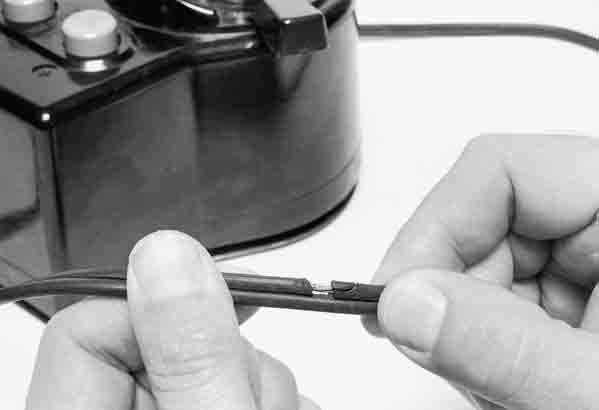
Examine your transformer cord before you plug it in. If it’s an old transformer, look for signs of deterioration or damage. Be sure that the plug is still firmly attached and there are no bare wires or gaps. Bad cords can be dangerous, so, if in doubt, replace it. Let a qualified electrical specialist do the job.
Working transformers usually hum or vibrate and get warm to the touch when in use. Test the transformer’s output by connecting a short length of wire to one of the binding post terminals.
Then, with the throttle about halfway open, carefully touch the other end of the wire to the other terminal. There should be a small spark. If the transformer has more than two binding posts, the ones used for track voltage are usually labeled as such.
Inspect the locomotive
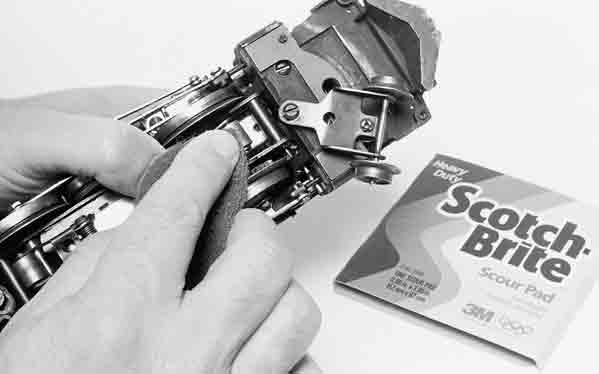
Turn the engine on its back. Spin the wheels to see that everything moves freely. Check for loose or damaged parts. If the locomotive is a postwar Lionel with Magne-Traction, make sure that no stray metallic objects are clinging to it.
If the drive mechanism is clogged with dust, rug fuzz, or cat hair, clean it out as best you can with WD-40 on a swab. Probe gently as far as you can see. Stay away from the mechanical sequence-reverse unit (also called an E-unit) if your locomotive has one. And avoid any green circuit boards. Still stuck? Check out our troubleshooting article.
Clean the wheels
This is essential for good electrical contact. Using your Scotch-Brite pad, remove the dirt and oxidation from all locomotive wheel rims. Scour them even if they don’t appear to be dirty, but be careful with wheels that have rubber traction tires. You don’t have to clean the rubber tire. If you don’t have a Scotch-Brite pad or something similar to clean the wheels, use a pencil eraser.
In the same way, clean the third-rail pickup shoes. Rub them until they shine. Whether sliders or rollers, these pickup shoes are spring loaded and should bounce back when depressed. If yours don’t, try to find the obstruction. Usually it is dirt.
Car wheels and couplers can best be cleaned by using cotton swabs sprayed with WD-40. If you find a layer of accumulated “gunk” stuck to the wheel rims, scrape it off with a knife or sharp screwdriver blade before applying the WD-40. Mop up with dry cotton swabs. Wheels are clean when the dry swabs no longer turn black.
Lubricate the train
Put just one drop of oil on each of the axle bearings and exposed gear shafts. Don’t overlook the truck pivots. If desired, the gears themselves may be lubricated with a thin application of white lithium grease or petroleum jelly. Watch this helpful video to learn more.
On older Lionel and American Flyer locomotives with open-frame motors, lubricating the motor’s armature shaft is critical. One end of it can be found between the brush holders. The other end usually has a gear attached and is located on the opposite side of the mechanism. Use one drop of oil on each end. But be careful not to get any on the brushes or commutator face. Accidental runs or spills should be mopped up with a cotton swab at once.
Car wheels, especially those on prewar and postwar trains, should be lubricated in order to reduce friction. One drop of light household or machine oil, dispensed from the end of a toothpick, is all that’s required.
Test-run the train
This is the moment of truth. Put the engine on the tracks and turn on the power. After this kind of cleaning and lubrication, most locomotives in good condition will run, but a year or more of inactivity may leave them sluggish at first.
Be patient. It takes time for the lubricant to penetrate dry bearings. Internal parts, like the electrical contacts on the reverse unit, may need to be exercised a few times before they consistently perform as they should.
Put the locomotive through its paces. Let it warm up. Run it fast and slow, forward and backward, for 10 to 15 minutes.The unit’s performance should improve with use as the gremlins disappear and it gets up to speed.
When you’re satisfied that the engine is running smoothly, couple on the rest of the train, sit back, watch, and enjoy. You don’t have to wait until Christmas.
If your train needs more serious attention, there are hobby shops that repair trains located throughout the country.





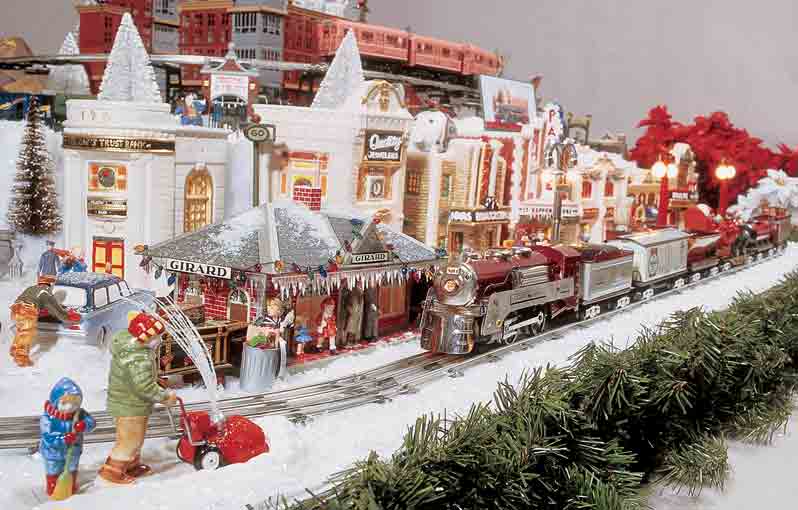

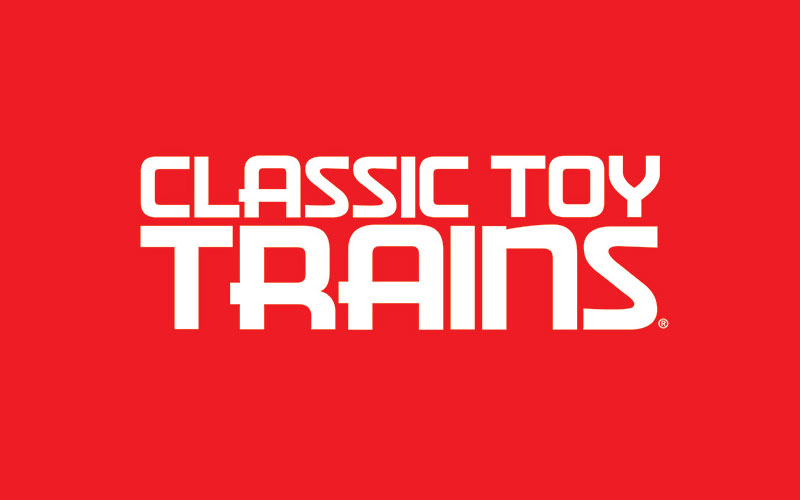
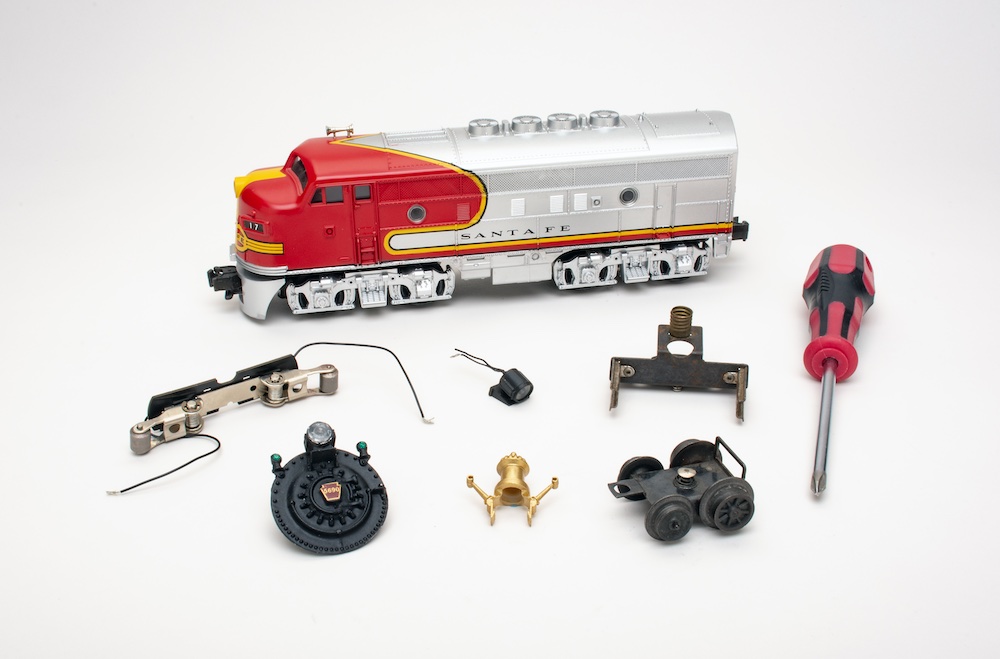
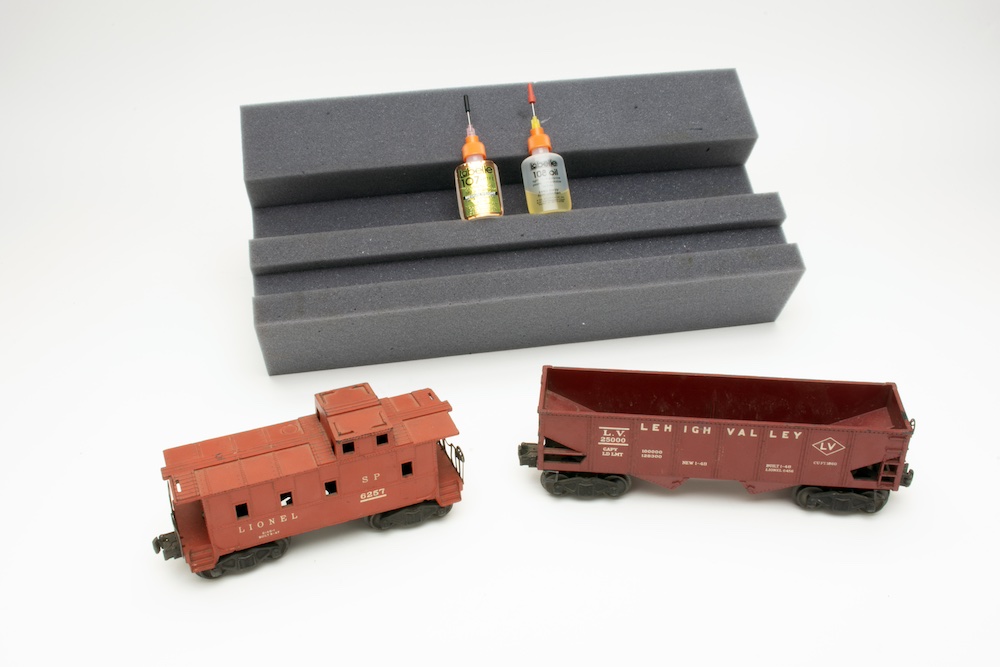
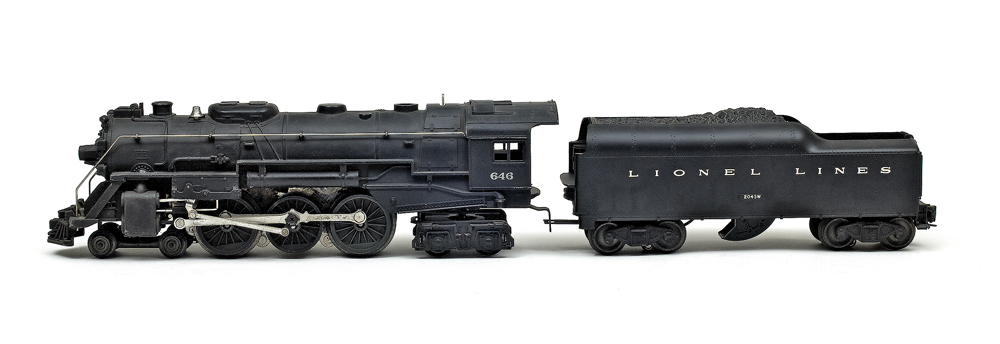




Good information. How can one clean up the stuff leftover after you spray the wheels, gears, etc. Pretty messy on mine. Ed
Can anyone recommend a specific type of oil to use to lubricate the car wheels? And this is really better than a dab of WD40 to loosen up post-war wheels?
Thanks for your reply!
Matt
In addition to scraping the build-up of dirt from the postwar (1945 to 1970, approx.) freight car wheels, I use a pencil eraser or dremel tool with a smooth brush to remove really stubborn dirt.
Also, the postwar axles may need more than one drop (sometimes up to six drops) of oil to spin freely, especially if it has been more than ten years since last used.